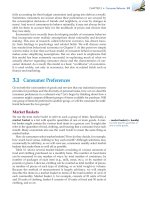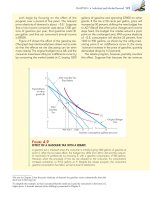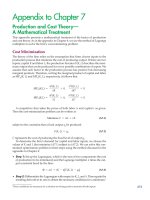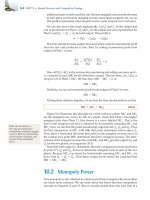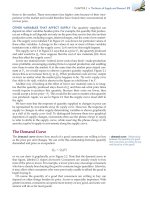(8th edition) (the pearson series in economics) robert pindyck, daniel rubinfeld microecon 147
Bạn đang xem bản rút gọn của tài liệu. Xem và tải ngay bản đầy đủ của tài liệu tại đây (121.88 KB, 1 trang )
122 PART 2 • Producers, Consumers, and Competitive Markets
Clothing
(units per
month)
F IGURE 4.8
UPWARD-SLOPING DEMAND
CURVE: THE GIFFEN GOOD
B
When food is an inferior good, and when the
income effect is large enough to dominate
the substitution effect, the demand curve
will be upward-sloping. The consumer is initially at point A, but, after the price of food
falls, moves to B and consumes less food.
Because the income effect EF2 is larger than
the substitution effect F1E, the decrease in
the price of food leads to a lower quantity of
food demanded.
U2
A
D
U1
O
F2 F 1
E
Substitution Effect
Income Effect
Total Effect
Food (units
per month)
inferior goods, the income effect is rarely large enough to outweigh the substitution effect. As a result, when the price of an inferior good falls, its consumption
almost always increases.
A Special Case: The Giffen Good
• Giffen good Good
whose demand curve slopes
upward because the (negative)
income effect is larger than the
substitution effect.
E XA MPLE 4 .2
Theoretically, the income effect may be large enough to cause the demand curve
for a good to slope upward. We call such a good a Giffen good, and Figure 4.8
shows its income and substitution effects. Initially, the consumer is at A, consuming
relatively little clothing and much food. Now the price of food declines. The decline
in the price of food frees enough income so that the consumer desires to buy more
clothing and fewer units of food, as illustrated by B. Revealed preference tells us
that the consumer is better off at B rather than A even though less food is consumed.
Though intriguing, the Giffen good is rarely of practical interest because it
requires a large negative income effect. But the income effect is usually small:
Individually, most goods account for only a small part of a consumer’s budget.
Large income effects are often associated with normal rather than inferior goods
(e.g., total spending on food or housing).
THE EFFECTS OF A GASOLINE TAX
In part to conserve energy and in part to raise revenues, the U.S. government has often considered
increasing the federal gasoline tax. In 1993, for
example, a modest 4.3 cent increase was enacted
as part of a larger budget-reform package. This
increase was much less than the increase that
would have been necessary to put U.S. gasoline
prices on a par with those in Europe. Because an
important goal of higher gasoline taxes is to discourage gasoline consumption, the government
has also considered ways of passing the resulting
income back to consumers. One popular suggestion is a rebate program in which tax revenues
would be returned to households on an equal percapita basis. What would be the effect of such a
program?

